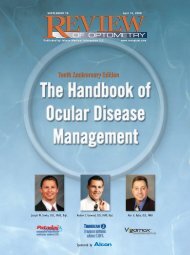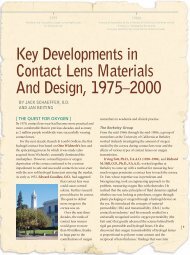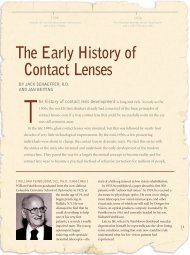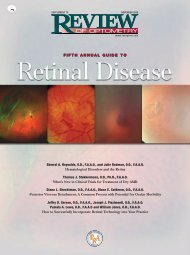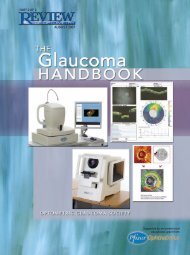Create successful ePaper yourself
Turn your PDF publications into a flip-book with our unique Google optimized e-Paper software.
1948<br />
Kevin Tuohy patents first corneal contact lens (made <strong>of</strong> PMMA)<br />
<strong>Contact</strong> lens sales quadruple.<br />
1950<br />
George Butterfield introduces modern concept <strong>of</strong> fitting the lens on the Ks.<br />
6 |<br />
surface in 1950, introducing the modern concept <strong>of</strong><br />
fitting the lens on the Ks. 1 During the 1950s and 1960s,<br />
corneal PMMA lenses—made by Obrig Laboratories,<br />
Breger-Mueller-Welt in Chicago, and the Plastic <strong>Contact</strong><br />
Lens Co (Wesley-Jessen), among others—also became<br />
thinner and smaller.<br />
Unfortunately, PMMA, like glass, is impermeable to<br />
oxygen. <strong>The</strong> resulting corneal oxygen deprivation caused<br />
many problems for contact lens wearers that researchers<br />
would spend decades more trying to address.<br />
[ NEWTON K. WESLEY, O.D., F.A.A.O. (B. 1917) ]<br />
Newton K. Wesley, O.D., is <strong>of</strong>ten<br />
credited with developing the first<br />
commercially successful rigid<br />
contact lens, in the mid-1950s.<br />
His lens, building on what Tuohy<br />
and Butterfield had done, was a<br />
9.2-diameter lens, fit on the<br />
flattest K. “It’s interesting that, all these years later, 9.2 is<br />
still the best diameter,” said Frank Fontana, O.D., one <strong>of</strong><br />
the founders <strong>of</strong> the AOA <strong>Contact</strong> Lens Section.<br />
But his greatest contribution to the field <strong>of</strong> contact<br />
lenses may have been in his teaching skills. Dr. Wesley<br />
and a former student <strong>of</strong> his, George Jessen, O.D.,<br />
together started the Plastic <strong>Contact</strong> Lens Company, later<br />
to be called Wesley Jessen VisionCare, Inc., a leading<br />
manufacturer <strong>of</strong> specialty contact lenses, including toric,<br />
colored and opaque cosmetic lenses. Wesley Jessen was<br />
eventually acquired by CIBA Vision in 2001.<br />
“Wesley and Jessen taught all <strong>of</strong> us how to fit contact<br />
lenses,” Dr. Fontana said. “<strong>The</strong>y almost single-handedly<br />
developed the market for contact lenses, just by traveling<br />
around the country educating people.” At the time,<br />
contact lens fitting was still a new field, and many<br />
thought contact lenses were unsafe; but Dr. Wesley and<br />
Dr. Jessen believed wholeheartedly in them. <strong>The</strong>y<br />
continued to develop new lenses for decades, achieving<br />
FDA approval <strong>of</strong> their own hydrogel s<strong>of</strong>t contact lenses<br />
in 1978.<br />
In 1955, Dr. Wesley founded the National Eye<br />
Research Foundation, best known for its orthokeratology<br />
and keratoconus work, and remained its chairman for<br />
many years. In the 1990s, he pursued s<strong>of</strong>tware<br />
applications for retinal sensitivity analysis. Well into his<br />
80s, Dr. Wesley continued to be an active entrepreneur<br />
and innovator.<br />
[ OTTO WICHTERLE, PH.D. (1913-1998) ]<br />
Otto Wichterle was a brilliant Czech<br />
polymer chemist who had<br />
already worked on one<br />
<strong>of</strong> the world’s first<br />
synthetic fibers. In 1954,<br />
he and colleague<br />
Drahoslav Lim at the<br />
Institute <strong>of</strong><br />
Macromolecular Chemistry<br />
<strong>of</strong> the Czechoslovak<br />
Academy <strong>of</strong> Sciences<br />
invented the first hydrogel<br />
material, hydroxyethyl<br />
methacrylate (HEMA). <strong>The</strong>y were seeking a synthetic<br />
biocompatible material for implants elsewhere in the<br />
human body and initially published their findings in<br />
the journal Nature in a 1959 article entitled<br />
“Hydrophilic gels for biological use.”<br />
When a chance encounter with an ophthalmologist<br />
on a train gave Pr<strong>of</strong>. Wichterle the idea that the gels<br />
he was working with would also be effective in the<br />
eye, he began his successful quest to make a contact<br />
lens. He later worked with American collaborator<br />
Robert Morrison, O.D., and others to improve<br />
the lenses.<br />
<strong>The</strong> original Wichterle lenses provided relatively<br />
poor acuity with thick yellowish material, but they were<br />
comfortable, according to Mandell. 1 <strong>The</strong> HEMA<br />
material was transparent, free <strong>of</strong> impurities, and was<br />
permeable to oxygen and water-soluble nutrients. Pr<strong>of</strong>.<br />
Wichterle patented his lenses in the U.S. in 1962 and<br />
1965. Mandell notes that these original lenses were by<br />
no means a great success prior to their refinement and<br />
commercialization by Bausch & Lomb, 1 which<br />
eventually acquired the patents for the HEMA contacts.<br />
Pr<strong>of</strong>. Wichterle quickly realized that he also needed a<br />
faster, more reliable method <strong>of</strong> fashioning the HEMA



